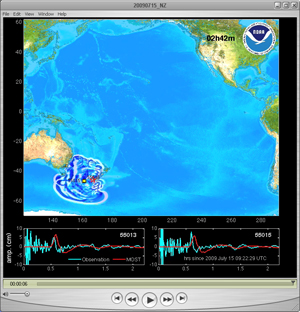Tsunami Symposium Sees NOAA Research Forecast in Action
July 17, 2009
During a session on tsunami forecasting during an international meeting in Russia on July 15, scientists saw NOAA’s Internet-based tsunami research forecast system in action.
A tsunami was generated by a large earthquake off the southwest coast of New Zealand. Vasily Titov, of NOAA’s Pacific Marine Environmental Laboratory in Seattle, Wash., and session chair, immediately accessed the web-based NOAA tsunami forecast system and demonstrated, before a live audience of 60 international tsunami scientists, a real-time tsunami forecast.
His demonstration included real-time access to tsunami data from a nearby deep-ocean detection buoy, part of the DART® (Deep-ocean Assessment and Reporting of Tsunamis) real-time tsunami monitoring system, developed by PMEL. The buoys are positioned at strategic locations throughout the ocean.
“Using these tsunami data assimilated into a forecast model, he predicted live that the tsunami would not be destructive to the coastlines of New Zealand or Australia before the tsunami arrived at any large coastal communities,” said Eddie Bernard, director of PMEL, who was present at the meeting. "His prediction was later validated as tide gauges in the area reported tsunami amplitude less than 50cm (1.5 feet) with no flooding."
Bernard said that he hopes the Internet-based system will become a new way of conducting research through community modeling for tsunami scientists.
Bernard noted that Titov, developer of NOAA’s tsunami forecast system, grew up in Novosibirsk, Russia, a Siberian city located in the center of the Asian continent and is possibly the safest tsunami city in the world.
The Dusky Sound earthquake, which caused the tsunami, was the largest earthquake on the main islands of New Zealand in 75 years, said Bernard.
NOAA understands and predicts changes in the Earth's environment, from the depths of the ocean to the surface of the sun, and conserves and manages our coastal and marine resources.

